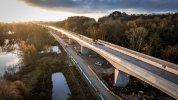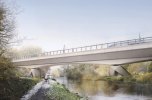It used to be normal to have no access for retensioning the deck; there was none on the only post-tensioned bridge I worked on. The strands were stressed and locked-off, the ducts grouted, the jacks removed and an in-situ concrete diaphragm poured across the back of the anchorages.
That was nearly 50 years ago though, and I think that specifications may have changed since. There have been a number of cases where post-tensioned road bridges have had to have major repair work because of loss of prestress or of tendon corrosion. AIUI tendons are now normally not grouted, and designs are more likely to consider how to access the tendons to carry out remedial work if and when necessary.
There is a lot of detail about the three kinds of post-tensioning in the PWI presentation linked from post #157 (from 20 minutes). That makes the point that for structures made of precast segments, internal (i.e. in holes through the solid part of segments) PT was banned over 30 years ago. For this one, they have put in extra features to overcome that - notably lining those channels with insulating waterproof pipes.
It also shows (but with words and pictures not always matching each other) that these three PT systems are:
1. cantilever PT, with tendons from the face of each added segment on one side to its opposite number
2. continuity PT, through the midspan join between matching segments on each side of it, stopping short of the piers
3. external PT, which is in the main void within the segments, tensioned above the piers, and always accessible during service.
Only 1 has to be put in during erection, and it does not go through the midspan.
I always wondered whether they really, as most of the videos seemed to show, built the cantilevers using just glue to hold them in place - it sounds so unlikely. Now I know they don't do that. I was also puzzled by their describing the angled walls on the sides, under the walkways, as "non-structural". It turns out they do hold up the edges of the deck, but are not part of the main bridge structure - not connected between segments.
That's what I made of the presentation, but I'm not a structures engineer - so please do correct anything that's wrong.

www.instagram.com




 . (But one hopes cleanign will be in the maitenance schedule)
. (But one hopes cleanign will be in the maitenance schedule)